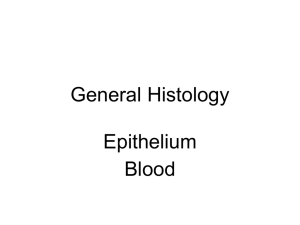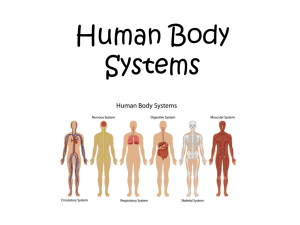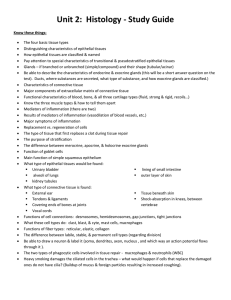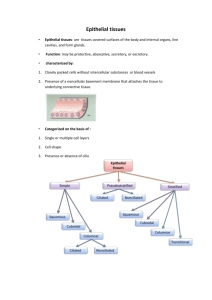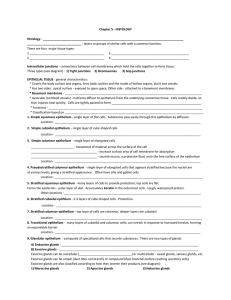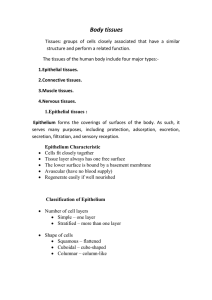MINISTRY OF HIGHER EDUCATION BABYLON UNIVERSITY COLLEGE OF DENTISTRY
advertisement
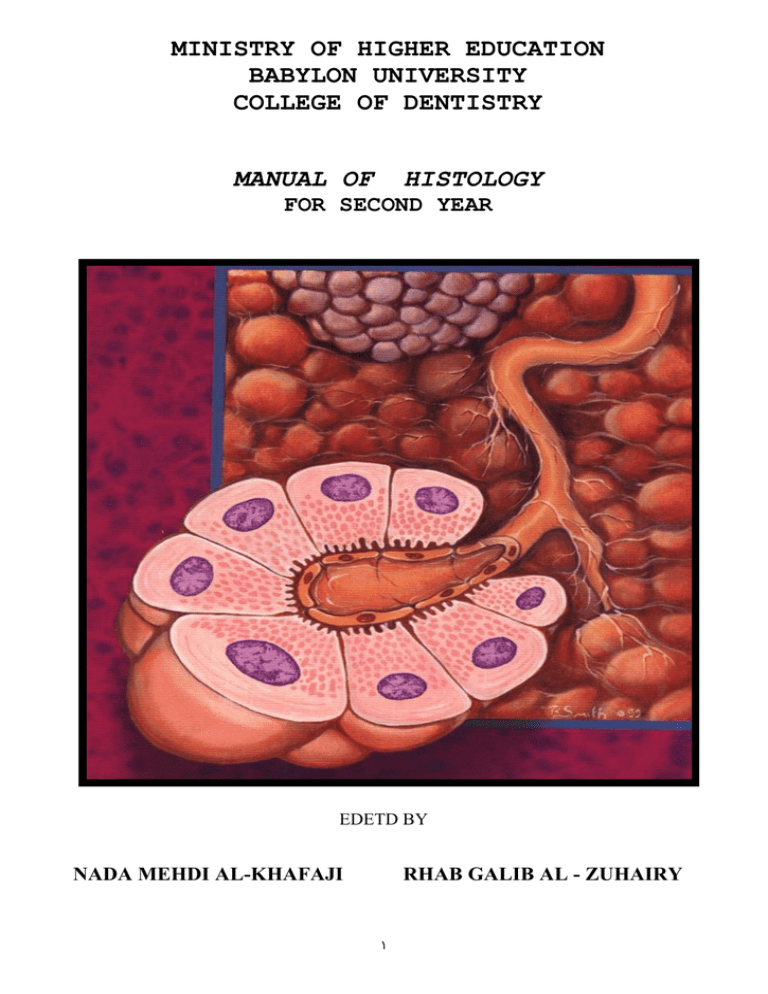
MINISTRY OF HIGHER EDUCATION BABYLON UNIVERSITY COLLEGE OF DENTISTRY MANUAL OF HISTOLOGY FOR SECOND YEAR EDETD BY NADA MEHDI AL-KHAFAJI RHAB GALIB AL - ZUHAIRY 1 M. Sc. In animal physiology physiology M. Sc. In animal THE TISSUES A. B. C. D. Four main groups of tissues are known in the body. These are: Epithelial tissues. Connective tissues. Muscular tissues. Nervous tissues. A- THE EPITHELIAL TISSUES These tissues arise from any of the three primary germ layers, the ectoderm, endoderm or mesoderm. They are almost always found covering a surface, external or internal, thus mainly performing a protective function. But some of them are specialized in various ways to perform different other functions. The epithelial tissues are characterized by having very little intercellular substance or matrix between their cells and by resting, in the majority of cases, on a basement membrane formed of the underlying connective tissues. Classification of Epithelium Cell arrangement and cell shape classify the epithelium, not by function -Simple, when it is one cell layer thick -Stratified, when it is two or more cell layers 1. 2. 3. 4. 5. The individual cells that compose an epithelium are described as: Squamous, where the width of the cell is greater than its height Cuboidal , where the width, depth ,and height are approximately the same Columnar , where the height of the cell appreciably exceeds the width (the term low columnar is often used where a cells height only slightly exceeds its other dimensions ). Pseudostratified epithelium has the appearance of being stratified. Some of cells do not reach the free surface; however, all rest on the basement membrane. Thus, it is actually a simple epithelium. Transitional epithelium has several layers of cells, characterized by large, dome-shaped cells at the free surface, that help maintain the integrity of the epithelium during distention of the various components of the urinary tract. 2 CLASSIFICATION SOME TYPICAL LOCATIONS Lining of vascular system (endothelium) , Simple squamous Bowman s capsule (kidney) Lining of respiratory spaces in lung Small ducts of exocrine glands Simple cuboidal Surface of ovary (germinal epithelium) Kidney tubules Lining of small intestine and colon stomach Simple columnar Lining and gastric glands lining of gallbladder Lining of trachea and bronchi Pseudostratified Lining of differences efferent ductules of epididymis Epidermis Stratified Squamous Lining oral cavity and esophagus Lining of vagina Sweat gland , ducts larger ducts of exocrine Stratified cuboidal glands Anorectal junction Largest ducts of exocrine glands Stratified columnar Anorectal Junction 3 Transitional Renal calyces Ureters Bladder Urethra 4 AV: artriole , vessel supplying glomerulas , BV: blood vessel CT: connective tissue EP : epithelium ,F : fibroblast nucleus N : nucleus SM: smooth muscle Arrow, site of bile canaliculus Asterisk,tubule possessing . 5 BC : basal cell ,C: cilia, CC : columnar cell CT : connective tissue Arrows: Fig . 1, tubule composed of simple siquamous epithelium ; Fig.2, lateral boundaries of cuboidal tubules cells; Fig 3, lymphocytes in epitheliunm Asterisk, duct or tubule of simple cuboidal epithelium Glands Glands are composed of epithelial cells specialized to synthesize and secrete a specific product. Typically, glands are classified into two major groups reflecting how their products are distributed: Exocrine glands, secrete their products onto a surface through ducts or .The ducts, also composed of epithelial cells. Endocrine glands, lack a duct system. They secrete their products into the connective tissue from which they enter the blood stream in order to reach their target cells. The products of endocrine glands are hormones. Exocrine glands are classified as either unicellular or multicellular: 1Unicellular glands: are the simplest in structure, the secretory component consists of single cells distributed among other cells that are not secretory. A typical example is the goblet cell, mucus-secreting cell positioned among other columnar cells. Goblet cells are located in the surface lining and glands of the intestines and in certain passages of the respiratory tract. 2Multicelluar glands: are composed of more than one cell and exhibit varying degrees of complexity. Their structural organization allows for subclassification according to the arrangement of the secretory cells and the presence or absence of branching of the duct elements. If the duct is unbranched, the gland is called simple; if the duct is branched, it is called compound. If the secretory portion is shaped like a tube, the gland is tubular; if it is shaped like a flask, the gland is alveolar or acinar; if the tube ends in a sac like dilation, the gland is tubuloalveolar. Tubular secretory portions may be single or branched. Thus, exocrine glands may be described as: Simple tubular, as in the intestinal glands of the colon Simple coiled tubular, as in the eccrine sweat glands Simple branched tubular, as in the submucosal glands of Brunner in the duodenum Simple branched acinar, as in the cardiac glands of the stomach Compound acinar, as in the pancreas Compound tubuloacinar, as in the submandibular gland Mucous and serous glands, are so named because of the type of secretion produced .The secretory cells of exocrine glands associated with the various body tubes, i.e., 6 the alimentary canal, respiratory passages, and urogenital system, are often described as being mucous, serous, or both. Tubular Compound acinar tubuloacinar 7


